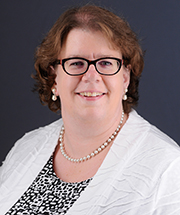I2S scientist receives NSF award for research focused on cardiac tissue ablations
LAWRENCE — A computational scientist with the University of Kansas School of Engineering and Institute for Information Sciences (I2S), is part of a team of researchers that received $283,686 from the National Science Foundation to develop a scientific computing platform for characterization and monitoring of cardiac tissue ablations.

KU’s Suzanne Shontz, whose expertise is in parallel scientific computing with a focus on mesh generation and numerical partial differential equations (PDEs), will join principal investigator Cristian Linte, a biomedical image computing expert with the Rochester Institute for Technology, and partners to provide an understanding of the physiological mechanisms that govern heat transfer into biological tissues.
This understanding, according to the researchers, is essential to advancing research in developing less invasive treatment options than cardiac ablations, which convert abnormal heart tissue to scar tissue, so that abnormal heart electrical signal pathways are interrupted.
With as many as 50% of ablation patients experiencing reoccurrence of cardiac arrhythmias, the development of noninvasive methods to resolve the abnormal cardiac electrical signals promise to reduce these numbers. Although the project focuses on providing a solution to a particular problem, the methods and products developed to do so are expected to have broader applications. For instance, a better understanding of the physiological mechanisms that govern the transfer of heat into biological tissues by modeling and quantifying tissue responses to thermal energy could potentially lead to future tools to better guide and monitor cardiac ablation therapy.
“In fact, on the PDE solver side, uses could be even more expansive than for just medical purposes,” Shontz said. “Discoveries in heat transfer technology could be applied to mechanical or aerospace applications, for example.”
Joining Linte and Shontz on the NSF Computational and Data-enabled Science and Engineering Grant is RIT mechanical engineer Satish Kandlikar. In addition to the institutional support provided by I2S and RIT, the group also will work with cardiologists at the University of Rochester Medical Center and an ablation modeling expert at Medical University of South Carolina.
The project will also feature educational and outreach initiatives to train the next generation of scholars and researchers.
Shontz, who is also KU’s center director for the Mathematical Methods and Interdisciplinary Computing Center and the engineering school’s associate dean for research and graduate programs, will incorporate the mesh generation concepts and rapid PDE solvers into her parallel scientific computing course. Plans also include workshops to engage K-12 students on computational bioengineering topics and a summer camp to attract a diverse group of students, along with a one-day WE’re in Motion event for incoming female engineering students.